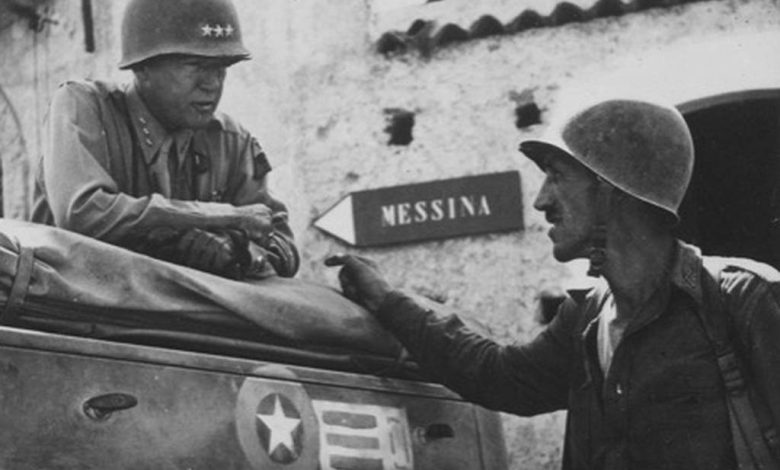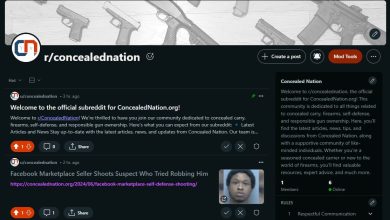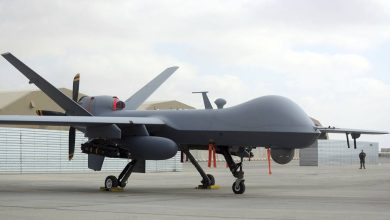Patton’s Prayer: Discussing the famed general with author Alex Kershaw

“I didn’t get frightened until three weeks after it had begun, when I began to read the American papers and found … how near we were to being whipped,” President Dwight D. Eisenhower confessed at a presidential press conference a dozen years after the December 1944 Battle of the Bulge.
The Bulge had exploited widespread intelligence failures on the side of the Allies, with the Germans’ two-pronged attack toward the Meuse threatening Paris and Antwerp — the key Belgian port supplying the Allies.
On Dec. 19, 1944, three days after the initial German assault began, grim-faced Allied leadership met in Verdun to concoct a plan to blunt the Nazi offensive. Except they didn’t need a new plan. Gen. George S. Patton was already three steps ahead.
Patton had arrived in Verdun with three alternative strategies, while his deputy, Maj. Gen. Hobart Gay, waited for word in Nancy, France. Patton was to call Gay with a telephone code, which would instruct him to immediately activate his troops.
“George,” said Eisenhower, unknowingly instructing Patton, “I want you to command this move — under Brad’s supervision, of course — making a strong counterattack with at least six divisions. When can you start?”
“As soon as you’re through with me,” Patton claimed. “I can attack the day after tomorrow morning.”
Patton’s aide, Lt. Col. Charles R. Codman, recalled “a stir, a shuffling of feet, as those present straightened up in their chairs. In some faces skepticism [showed]. But through the room a current of excitement leaped.”
Taking tens of thousands of men facing eastward, swiveling them north, and moving them — over inadequate and icy roads with armor and supplies set up for a different thrust — to counterattack two days later seemed logistically unsound, according to historian Stanley Weintraub.
Yet Patton was confident he could do it — and he did.
And while that tale has certainly been well-plodded, author and historian Alex Kershaw latest book, “Patton’s Prayer: A True Story of Courage, Faith, and Victory in World War II,” offers a deep dive into the course altering decision making surrounding the Bulge.
Kershaw spoke to Military Times about his most recent project, how faith and ego intertwined that fateful winter, and how such factors led to an astounding American victory.
Editor’s note: Answers have been edited for clarity.
Patton is, of course, a colorful character in American history — a lot of good, a lot of bad. Did anything about him surprise you while researching for this book?
The reason I chose to write about Patton during this time period is because I wanted to show him at his very best — and boy was he at his very best here. I was surprised at how strategic he was, his planning, what a great staff he had.
I was very impressed by the fact that he was often right there on the front lines. In my book, there are several instances where he was very nearly killed. I can’t think of a single U.S. Army commander who was that close to the front so often — so close to death.
So, this was obviously a guy who was a hot head, who blasphemed, the most politically incorrect character in history, maybe, but he performed. He walked it like he talked it. He was our best. The Allied best.
There’s a claim that the Germans only feared one Allied general — Patton. How overblown is that?
I don’t think they were just scared of Patton, but if you look at the German accounts… [Gerd] von Rundstedt wrote after his arrest that Patton was our best.
I came across one account where Hitler called him the American cowboy. There’s nothing wrong with being a cowboy here… [laughs]
War is fought on strategic, tactical, and operational levels. The operational level binds the other two but is less glamorous and often left out of narratives. How important are “nuts and bolts” when retelling the story of Patton in 1944? How important was his staff to his success?
It’s indicative of a very skilled commander at that level. The Third Army by the end of the war had almost 450,000 Americans — 36 divisions I believe. [Patton] practiced what I like to call American Blitzkrieg. He was the primary theorist in American armored warfare.
He was the first [American] to actually drive a tank towards combat during World War I because he was the only guy who knew how to drive it. So, he’s a pioneer in so many ways. You could say that today’s combined arms doctrine was invented by Patton before it was even official.
So, when he got the chance to move, and summer 1944 is the perfect example of this, his army was so powerful, moved so quickly, so effectively. The only thing that stopped him was running out of gas. But if you practice that kind of warfare you don’t worry about your flanks. And he didn’t. He let the enemy worry about that. We’re just going to kill, kill, kill. Move, move, move. Always engage the enemy. Never let them rest. It’s a very swashbuckling cavalry mentality.
But to do that, you have to have a very large and intelligent staff who can provide information about where you’re moving to. They need good information, on time, as quickly as possible because they are moving so fast. You’ve got to exploit weaknesses, exploit places where units can break through and push hard in those places. He had one of the largest intelligence staffs of any in the U.S. Army.
His head of intelligence [Oscar] Koch had been with him since before Operation Torch in 1942, so they went way back. Patton wouldn’t make any decision without consulting Koch.
By 1944 it was a very well-oiled machine. So, in late November, early December of that year Patton and his intelligence team were getting disturbing information back to them. When the Battle of the Bulge began on December 16, there was only one man with a plan — Patton — because he had strongly suspected and made preparations for the surprise attack.
When, in the greatest act of his military career, he pivoted the entire Third Army and moved over 100 miles in about 48 hours in terrible conditions, horrible road networks and then relieved Bastogne, he could do so because he was prepared.
He actually pushed them too hard during the relief of Bastogne. You can only push tankers day and night for so long. Even the Wehrmacht in 1940, jacked up on amphetamines, didn’t go much longer than 48, 72 hours max.
The commanding officer at Bastogne was desperate to be saved — relieved I should say, but same thing. That’s not to say the 101st didn’t put up one hell of a fight. They were in desperate need of resupply, but a very clever and efficient use of whatever artillery the airborne could muster is what kept them going.
If the Germans had struck around the perimeter at Bastogne in a coordinated attack they probably would have overwhelmed them. But it was piecemeal, so [Anthony] McAuliffe could bring all the artillery to bear on that one place, with really devastating effect.
McAuliffe was an artillery officer, jumped at D-Day. So he was the right guy. If you had someone else you might have had a different outcome.
When you talk about the Battle of the Bulge (which Patton agreed with completely), the American soldier proved his worth. This isn’t some jingoistic, patriotic bullshit. They were tested more than they had ever been before. When the odds are even — you don’t have air support, terrible conditions and you’re up against really good SS troops, how does that turn out?
After the disaster of Market Garden, Hürtgen Forest was a meat grinder. The Germans outnumbered the Americans 3 to 1 and may have thought they had them on the ropes, but these thin American lines were desperately holding on.
Yes, you could say Bastogne is the perfect example of the Germans not doing the right thing. It was a clear defeat in the sense that they didn’t take Bastogne and they were pushed back. They failed because of American grit, courage, ingenuity and adaptability.
Patton took tens of thousands of men facing eastward, swiveled them north, and moved them to counterattack on December 22 — a week after the first assault. And Patton was confident he could do it.
First thing Patton did after the Verdun meeting on the 19th was call Hobart Gay, Patton’s chief of staff, and give him the codeword for one of the attacks.
So you could say it was Patton’s finest hour.
It was amazing. And not just because he was ready. He told Eisenhower he could go in 48 hours.
Eisenhower said, “Don’t go off half-cocked.” A British officer at Verdun just laughed out loud like it was a joke.
Patton was the only man who had a plan, the only Allied general who comes out of the Battle of the Bulge with his reputation significantly enhanced. And he made good on his promises.
Patton twice contacted Chief Chaplain of the Third Army James H. O’Neill about the weather. O’Neill responded, ‘It isn’t a customary thing among men of my profession to pray for clear weather to kill fellow men.’ Patton returned, ‘Are you teaching me theology or are you chaplain of the Third Army? I want a prayer.’ Thus, Patton’s Prayer was born. How did religion influence and guide him throughout the war?
One of the reasons I was interested in writing the book was that I was looking for a way to tell the story of Patton and the Battle of the Bulge and I didn’t want to write a biography. So, I used the prayer as a kind of device that allows me to have a structure to the book.
The prayer was answered, Patton believed, because the skies cleared, the air force comes into play. And many men in his army — there were 200,000 prayer cards distributed — believed it, too.
I looked at a U.S. Army survey done just after the war that showed that when guys were on the front lines, less than 50 percent believed that prayer was important. When they were in combat that number rose to 75 percent. GIs are praying. You can say they were just praying for survival, but it does show how much faith matters to people who didn’t think they were going to live.
Patton himself prayed every day. He writes in his diary messages to God. He cites God. He thanks God. He attends services when he can.
One of the reasons why he calls on his chaplain is that he didn’t think his men were praying enough.
When you think of Patton one doesn’t often picture piousness. Did anything surprise you while researching that aspect of the man?
I think he is underestimated in a lot of ways. I don’t think people understand just how smart George Patton was. He was highly read, probably more than any other Army commander in WWII. He was constantly educating himself and even had a mobile library. He was reading Julius Caesar as he was crossing Normandy.
Patton was more of an intellectual than Eisenhower, Bradley, and the rest of them put together. He understood how to be colorful, inspirational, larger than life, because that’s a man people can follow. He had faith and he had confidence. Without those two, you’ve got problems.
You hear mixed stories about egotistical leaders — MacArthur’s bravado, for example. MacArthur’s men, however, may not have loved him as men led by Patton’s did. Did you find that to be true?
Patton was often reviled by some of his men, because he was so strict. He was a notorious stickler for discipline, uniforms being as neat as possible.
One of his last commands the day after V-E day was that his soldiers had to continue to wear their helmet liner.
Ernie Pyle didn’t like him, thought he was a bit of a blowhard. Bill Mauldin famously had an engagement with him, but that discipline, that pride, adherence and toughness was what made the Third Army so great.
A veteran of Operation Market Garden once said the one thing that drove him crazy about the Brits was —
Tea? Okay, the cups of tea were very, very important.
For [Americans] it was coffee and cigarettes. American officers got good coffee — it wasn’t some instant shit, because they knew how important it was. They made that a priority. If you ran out of cigarettes? Woo, big problem.
Who cares how many grenades you’ve got when you’re without coffee and cigarettes? How long are you going to fight, or more importantly, how long are you going to keep fighting without either?
The same was true with us, but for us it was cigarettes, rum and tea.
People forget that tea has caffeine but there’s also a psychological aspect to the tea break, the brewup. It’s a pause, a respite. It’s like your guys having a coffee or a donut. It’s a pause from hell.
Whether divine intervention or just weather patterns, harsh weather stopped. Patton’s prayer was answered. Patton even pinned the Bronze Star to O’Neill’s chest, making him the only man awarded a medal in WWII for writing a prayer.
That’s a fantastic story. I think it was very soon after the weather cleared that Patton called for the chaplain. In the book I write that as Patton pushes towards Bastogne he essentially said, “Chaplains are going to go to work, too.”
They were expected to be on the front line, or near them — where they were needed. They played a very important role.
There are plenty of Patton-isms. Do you have a particular favorite? His ‘Xmas Eve present coming. Hold on’ radio to Anthony McAuliffe is a gem.
I think of the George C. Scott movie and his famous speech, which is based off of several of Patton’s speeches.
There are tons of lines in there like, “No bastard ever won a war by dying for his country. He won it by making the other poor dumb bastard die for his country.”
I think that’s one of my favorites because it’s Patton in a nutshell. That’s his whole philosophy.
Claire Barrett is the Strategic Operations Editor for Sightline Media and a World War II researcher with an unparalleled affinity for Sir Winston Churchill and Michigan football.
Read the full article here






